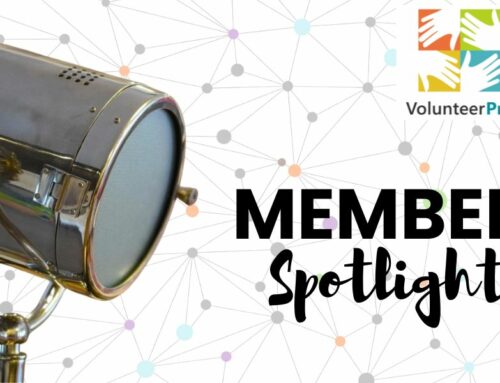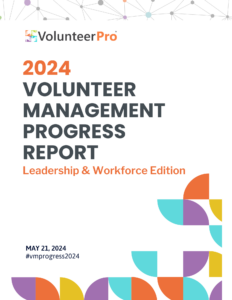July Pro Roundup: Using Volunteer Testimonials as Social Proof
Sharing volunteer testimonials is one of the most powerful ways to tap the benefits of social proof in your recruitment efforts.
If you’re not familiar with the term, “Social Proof” is a psychological concept that says, when faced with uncertainty, people have a tendency to look to their peers for what they should do.
It is also a marketing and advertising strategy that can be employed to persuasively move people to action from your volunteer recruitment communications.
In order to use this tactic effectively, this post includes more about what social proof is and how others are using it to steer their target audiences to action.
In this Pro Roundup, we’ve gathered a number of resources that will define social proof, explain why it is important in contemporary communications, and give you examples of ways to include it in your recruiting efforts.
What is Social Proof?
Seeing Others Solving a Problem You Have
“When you sign up for a demo because you see the tool solved the exact problem you have for a similar company, that’s social proof.”
Social Proof: What It Is, Why It Works, and How to Use It explains this result, giving a marketing perspective and examples. Here, you will learn about six types of social proof and how to incorporate data and storytelling, all of which are applicable in volunteer recruitment.
The article goes deliciously meta in that the author uses social proof to demonstrate the value of social proof, showing as telling – and convincing!
People Trusting Other People More Than Media or Organizations
Despite its title, 30+ Proven Ways to Use Social Proof to Increase Your Conversions (Updated) lays some groundwork on the concept of social proof before going into all of the samples.
In addition to the power of media mentions your organization might receive, this marketing-focused piece also suggests that the number of people who like your social media pages factors in when convincing people of your trustworthiness.
“More telling is the fact that product reviews are 12-times more trusted than product descriptions and sales copy from manufacturers.”
Replace ‘manufacturers’ from the above statement with ‘the organization itself’ to see the potential for testimonials in volunteer recruitment for your program.
Informational Social Influence
The Interaction Design Foundation’s blog What is Social Proof? defines the concept as it applies relative to the foundation’s mission of teaching online user design. In it, we learn that including social proof on a website delivers credibility and promotes acceptance of whatever call to action the page contains.
This article also touts the value of having customer ratings, the likes of which appear on Amazon and eBay, saying, “Highly rated and highly recommended products (and sellers) are more likely to be successful than those with poor or no ratings.”
The inference here is that your prospective supporters can be swayed by testimonials from current volunteers and donors. This would be an excellent application for positive volunteer survey results, as well.
Conformity to Socially Acceptable Behavior
Using a personal example that almost anyone can relate to, The Decision Lab’s Social Proof explains informational social influence in behavioral science terms.
In this version, the tendency to look around to see which fork everyone else is using when the salad course is served, is human nature.
“Essentially, we are looking to those around us for clues about the ‘right’ way to behave, especially in ambiguous circumstances.”
You’ll find some thought-provoking guidance on not taking the influence of social proof too far in sections about the consequences and controversies of its use.
Reasons to Use Testimonials in
Volunteer Recruitment
Showcase Your Satisfied Volunteers
From a marketing perspective, social media scheduling tool Sprout Social’s article Social proof: How to use psychology in digital marketing, gets right to the point. They use data (informational social influence) to prove the value of having social proof, stating:
“91% of shoppers read online reviews before making a purchase. 82% of Americans ask for referrals and recommendations from family and friends before making any kind of purchase.”
If we presume volunteer candidates are ”shoppers” in search of a meaningful experience, they may be looking for reviews to confirm this possibility when they evaluate opportunities.
Likewise, they will talk to peers about their volunteer experiences with an organization before committing to their own.
Positively Influence the Behavior of Potential Volunteers
In consulting to entrepreneurs, Oberlo’s blog post Social Proof: What It Is and Why It’s Great for Marketing also offers data to inform readers of the value of providing social proof.
They report:
- 91% of 18-34-year-olds trust online social proof reviews as much as recommendations from someone close to them
- 100% of those aged between 18-29 said they “checked reviews prior to making a purchase” in a 2018 eMarketer survey
- 82% of Americans say they value endorsements from friends and family before buying a product
- 70% of Americans seek out opinions from independent review sites before making purchases.
- 63% of consumers indicated they are more likely to purchase from a website with product ratings and reviews”
Note that their statistics are all derived from outside sources. In a pattern that has become familiar through these articles, they’re citing outside authorities, rather than assuming the reader will trust the organization’s word.
You can use this same technique by providing data and testimonials in volunteer recruitment, whether it’s in direct messaging, or through information on your website.
People Are More Likely to Do Something When Presented with Evidence That Others Have Done It
The argument for leveraging social proof in ecommerce made by What Is Social Proof and Why It’s Necessary for Ecommerce Success, is just as applicable for your organization’s recruitment messaging.
The crux of their rationale is, “Seeing other individuals – particularly like-minded ones that are in the same demographics – engaging with a business creates an immediate trust with people who are yet to be customers, and indicates your company provides quality service.“
In this case, photos can also serve as a kind of social proof. When focusing on attracting a particular group of volunteers, include photos of people like them on your website and in your recruitment materials. This can create an immediate, underlying sense of trust with your organization.
Social Proof is More Effective Now Than Ever
Another informative article on the ‘why’ of using social proof offers an everyday scenario that requires no replacement of words to understand, as it references examples with which we’re all familiar:
- “An empty restaurant at 7pm on a Friday makes us wonder, “Maybe the food isn’t so great?”
- “When should I show up?” “Who’s going to be there?” “What should I wear?”It’s not so much that you don’t want to be too early or too late. You just didn’t want to be the first one there. By the punch bowl. Alone…”
Social Proof: What Is It, Why It Matters, and How Do You Use It? goes on to discuss that using social proof has even more significance as organic reach on social media is waning, the cost of paid channels is increasing, and people trust media less and less.
Candidates Are Researching You
In speaking to the use of social proof for hiring professionals, What is Social Proof? and Why it’s Essential for Recruitment Agencies follows the journey of a candidate as they hear from and research a potential employer. It’s no great leap to find the parallels for your volunteer program.
Reiterating statistics on the decreasing effectiveness of paid advertising and the increasing distrust of media and brands, this piece argues the advantage of testimonials in volunteer recruitment just as well as in employment, stating:
“If your agency is trusted by the candidates and clients that you’ve worked with, then you stand to gain a better quantity and quality of both candidates and clients in the future.”
The same goes for volunteers.
Your Volunteers are the Voice of Authority
The Gem article, titled How to Use Social Proof in Your Talent Outreach, explains just that, stating that the use of social proof is the most powerful tool to use in recruiting talent. It gives examples of ways current volunteers can be engaged, at almost every stage, in the development of your volunteer talent pipeline.
Included are tips such as creating hashtags your volunteers can use to share and publicize events on social media, and the importance of including pictures with testimonials.
They summarize the argument for social proof up quite simply by saying:
“After all, nobody knows what it’s like to work at your organization better than the people who … well, work at your organization.”
Your current volunteers are the most credible messengers for your recruitment asks, hands down.
How to Use Social Proof and Testimonials in Volunteer Recruitment for Your Organization
Many of the previous blog posts and articles have given examples of how social proof is deployed.
Now that it’s on your mind, you won’t be able to scroll the web for the next few days without seeing ratings or testimonials everywhere. See if there are any use cases you might emulate for your own purposes (making sure you’re using real people and real quotes of your own, of course).
For a bit more definitive instruction on how to leverage social proof and testimonials in volunteer recruitment, we’ve got a few more resources in the Roundup.
Get Others Involved
The Psychology of Marketing: 18 Ways to Use Social Proof to Boost Your Results, a blog post from a social media scheduling tool, offers action-oriented ways to boost your organization’s online authority.
In essence, they’re instructing you on how to use the audience you have to reach larger audiences, which is the very idea of social media’s existence. Their tips are clearly stated, with examples of how others have achieved success in implementation.
See which might work for you, too.
Follow the Leader
Neil Patel is an online marketing guru. He’s a prolific speaker and creator of online tools to help people and organizations become better marketers.
In showing how readers can deploy certain methods for their own use, he often uses examples from his own successful videos, webpages and emails. His organizations employ the very best practices that he’s teaching others to use.
In this case, the company’s owner is the object of his own social proof.
In his post Social Proof: Your Key to More Magnetic Marketing , he lists testimonials as the first of ten effective social proof strategies. Knowing how Neil Patel practices what he preaches, it’s no coincidence that testimonials is placed at #1.
Do you have staff who were former volunteers? They can offer a very specific kind of social proof with knowledge of both sides of the experience.
Steer the Conversation
Another leader in online marketing education is the team from Social Media Examiner. They also can be observed walking the talk when it comes to employing the instruction they give. So, when they offer How to Use Social Proof in Your Marketing, you know the advice has been tried, tested and proven.
In addition to admonishing us to never underestimate the power of testimonials, they say we can cover even more ground if we:
“… make sure to include content that counters actual objections that potential customers may have, instead of solely focusing on those that praise or glorify your product.”
This is an excellent reminder to be real in your statements and not discount testimonials that include how hard the work is, or that people had challenges and doubts, but were able to overcome them.
Find What Works for You
This final piece is just so full of examples and creativity, it’s bound to stimulate some ideas for you to try in your use of social proof.
Social Proof: 26 Genius (And Easy) Marketing Examples to Try gives a virtual cornucopia of platforms, strategies and expressions of social proof that you can use to augment testimonials in volunteer recruitment and elsewhere through your organization’s communication.
With visuals accompanying every sample, you’re sure to find some new ways to incorporate social proof to try. Keep experimenting to see what resonates best with your audience.
Take Action: Use Social Proof and Testimonials in Volunteer Recruitment and More
You’ve learned what social proof is and how it can used to persuade an audience to action.
You’ve now seen a multitude of ways social proof can be integrated, not just in outreach and recruitment, but to add credibility and authority to your website and online presence.
For the next little while, you’ll probably be spotting evidence of social proof in places you never noticed it before.
Take note of the kinds of information and presentations that strike you as convincing and see if there’s a place for them in your organization’s communications.
With compelling stories and visuals from current volunteers, you’re one step closer to a consistent pipeline of volunteer talent.







